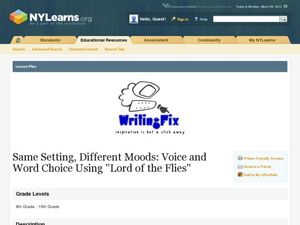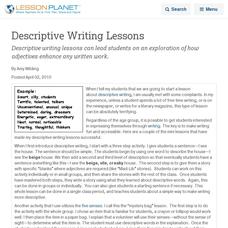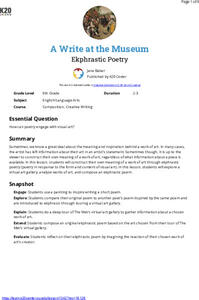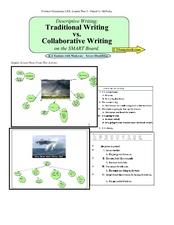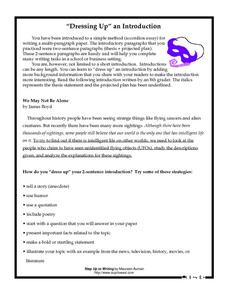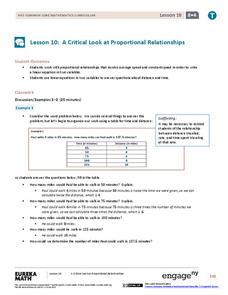Nosapo
Family Titles, Pronouns, Writing about a Person
How is your grandmother related to you? How is your cousin related to your grandmother? Learn about family relationships and pronouns with an activity that guides pupils to write two short narratives about members of their families.
Curated OER
Same Setting, Different Moods: Voice and Word Choice Using Lord of the Flies
Whether it's dark, delightful, or somber, set the mood with William Golding's Lord of the Flies. High-schoolers practice descriptive writing by creating the appropriate mood for an original scene, starring one of the book's main...
Curated OER
The "Write" Stuff: Strategies and Conventions for Imaginative Writing
A comprehensive and immersive series of lessons that examines various aspects of story development leads learners into writing a narrative of their own. Writers develop an understanding of the writing process as they use the learning...
Novelinks
Zach’s Lie: Guided Imagery
Close your eyes and picture a time where you decided to tell the truth to someone. What were you wearing? How did you feel? Such prompts begin a guided imagery activity for Zach's Lie. Directions for creating an environment conducive to...
Curated OER
Episodic Writing Using Pictures of Hollis Woods by Patricia Reilly Giff
Help your middle-schoolers expand their writing skills with this lesson on episodic writing, which focuses on story details, idea development, and organization. After reading "The Eighth Picture: End of Summer" from Patricia Reilly...
Curated OER
Descriptive Writing Lessons
Descriptive writing lessons can lead students on an exploration of how adjectives enhance any written work.
K20 LEARN
A Write At The Museum: Ekphrastic Poetry
Which came first—the painting or the poem? In this case, it is the painting. Scholars closely examine a work of art and then craft an ekphrastic poem in response. A carefully scaffolded nine-page plan leads young poets through the process.
Curated OER
Learning About Trees
After looking at pictures of trees, discussing tree growth, and identifying the parts of a tree, lead your class on a nature walk and have them collect samples and record their observations. They then work in pairs to polish the...
Curated OER
"Snapshot" Exercises & Sensory Detail Word Bank
Read a sample of creative descriptive writing to your science class. Discuss how writing can be used to record and communicate observations that scientists make. Reading selections and thought-provoking questions are suggested. Also...
Curated OER
Traditional Writing vs. Collaborative Writing
Students examine language arts by completing a group activity. In this writing styles lesson, students define and discuss the differences between collaborative writing and traditional writing while answering questions in a Smart Board...
Curated OER
Friendly Letter Writing and Sentence Structure
Explore communication through writing by analyzing individual sentences with young writers. They practice writing compound sentences and identifying sentence fragments. The next step has them learn the five parts of a friendly letter....
Curated OER
"Can Do!" Reading, Writing, and Understanding the Art of Technical Writing
Technical and informational writing is the most common type of writing that students will encounter. Using this SMART board activity, teach your 10th graders the four different types of technical writing. They can then practice following...
Curated OER
Writing Newsletters!
A reading of Gail Gibbons’ Deadline! leads to a discussion of the differences between newspapers and newsletters. Class members then choose a favorite topic and create the front page for their own newsletter.
Curated OER
Example of a Description of Action
Read the descriptive paragraph (included) with your middle schoolers, and have them study the stylistic elements included. They'll look for vivid verbs, alliteration, assonance, similes, and personification. Before writers craft their...
Curated OER
Magical Creatures Land
The opening of J.R.R. Tolkein’s The Hobbit provides a model of how to use rich details to create a setting. After reading the description of Bilbo Baggins’ abode, young writers create their own magical home for a fantasy creature. The...
Curated OER
Character Attributes in Writing
Third graders analyze the importance of characters in fiction writing and performances. In this theatre lesson, 3rd graders identify the important characteristics of a fictional character and how to portray a character through many...
Curated OER
Leads for Descriptive Writing
Students write two descriptive leads to learn how to reel in readers. After their leads have been written, they will share with a partner to decide which was the most appealing. In this leads lesson, students can also write a reflection...
Curated OER
So Much Depends Upon...Sixteen-Word Imagery Poems Inspired by Love that Dog by Sharon Creech
After reading Love That Dog by Sharon Creech (and possibly shedding a few tears), middle schoolers work on their own sixteen-word poems with a Six Trait writing activity. They focus on word choice in this activity to capture an...
EngageNY
Word Problems Leading to Rational Equations
Show learners how to apply rational equations to the real world. Learners solve problems such as those involving averages and dilution. They write equations to model the situation and then solve them to answer the question —...
Curated OER
Writing Pourquoi Tales
Complete research on Pourquoi tales and then lead your students in creating their own. This lesson accompanies another on Pourquoi Tales on our site and deals more with the writing process. Your class will put the tales together in a...
Curated OER
Fear Factor Fun
Students develop "Fear Factor" stunts using descriptive language. In this writing lesson, students watch clips from the show "Fear Factor" and develop their own stunts. Students write and explain the stunts in vivid language.
Anchorage School District
“Dressing Up” an Introduction
Are your pupils ready to move beyond a thesis statement by adding additional detail to their introductory paragraphs? Provide this handout to give your class some ideas for spiffing up their work. The page includes a sample paragraph...
Film English
Everyday
What would you do if you got an extra day every week? Partners share some information about their routines and lives and write compositions about one another based on the information. Each partner tries to guess what the other person...
EngageNY
A Critical Look at Proportional Relationships
Use proportions to determine the travel distance in a given amount of time. The 10th installment in a series of 33 uses tables and descriptions to determine a person's constant speed. Using the constant speed, pupils write a linear...



